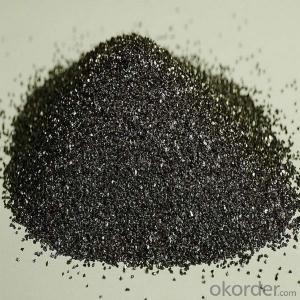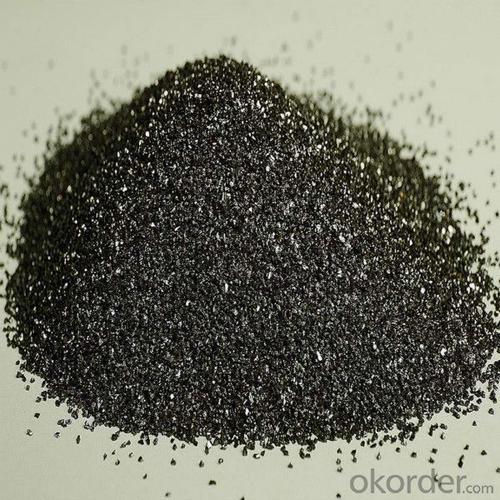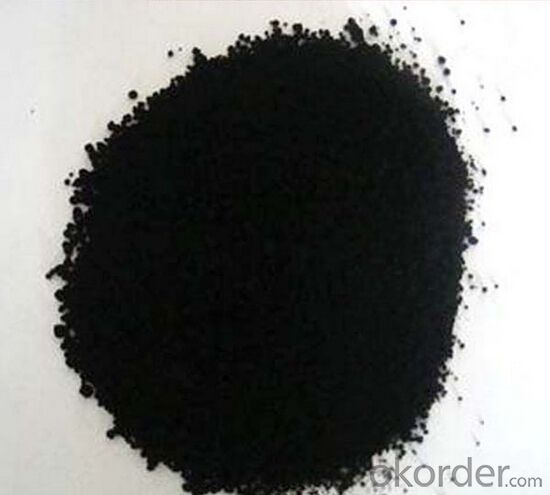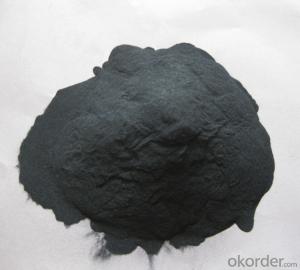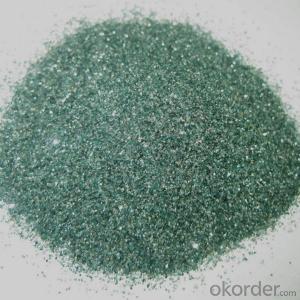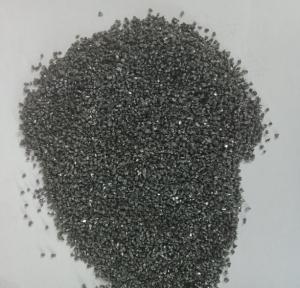Black Silicon Carbide Grit industry powder
- Loading Port:
- Qingdao
- Payment Terms:
- TT OR LC
- Min Order Qty:
- 10 m.t
- Supply Capability:
- 500000 m.t/month
OKorder Service Pledge
OKorder Financial Service
You Might Also Like
Specifications of Black Silicon Carbide:
Black silicon carbide grit F 24-240, sic 98.5%min, F.C 0.2%max, Fe2O3 0.3%max. Packing:25kg bags be packed into 1mt big bags.
- Description:
Black silicon carbide is produced at high temperature in an electric resistance type furnace with quarts sand and petroleum coke as its main raw materials. Its hardness is between fused alumina and synthetic diamond. Mechanical intensity of it is higher than fused alumina. It is sharp and has electrical and heat conductivity in some degree.
- Application:
♦As the abrasive: used for abrasive, such as grinding wheels, whetstone, grinding
wheel, sand tiles etc.
♦As the metallurgical deoxidizer and high temperature material.
Four main application areas of SiC: functional ceramics, advanced refractory,
abrasives and metallurgical materials.
♦High purity single crystal, used to manufacture semiconductors, manufacture of
silicon carbide fibers.
♦Silicon carbide is very hard, with excellent thermal conductivity, as a semiconductor
and high temperature resistant to oxidation.
- Specification:
Grits: F12-90, F100-240.
SIZE | SIC | F.C | Fe2O3 |
F24-90 | 98.5%min | 0.20%max | 0.30%max |
F100-150 | 98.0%min | 0.25%max | 0.30%max |
F180-240 | 98.0%min | 0.30%max | 0.30%max |
SIZE | BULK DENSITY | HIGH BULK DENSITY |
F16-24 | 1.42-1.50 | ≥1.50 |
F30-40 | 1.42-1.50 | ≥1.50 |
F46-54 | 1.43-1.51 | ≥1.51 |
F60-70 | 1.40-1.48 | ≥1.48 |
F80 | 1.38-1.46 | ≥1.46 |
F90 | 1.37-1.45 | ≥1.45 |
F100 | 1.36-1.45 | ≥1.45 |
F120 | 1.34-1.43 | ≥1.43 |
F150 | 1.32-1.41 | ≥1.41 |
F180 | 1.31-1.40 | ≥1.40 |
F220 | 1.31-1.40 | ≥1.40 |
F240 | 1.31-1.39 | ≥1.39 |

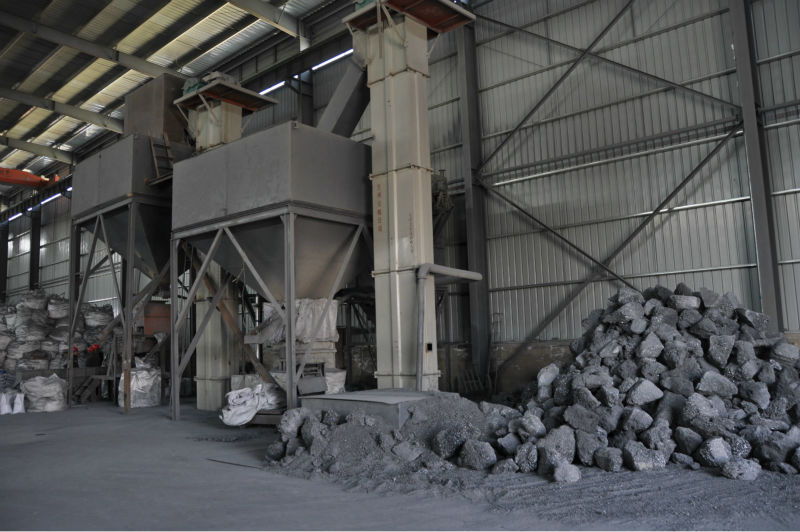
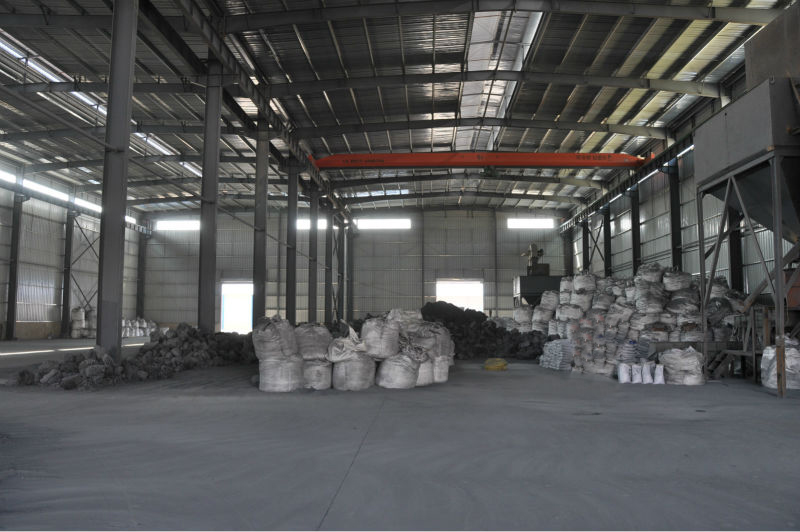
- Q: What are the challenges and opportunities of transitioning to a low-carbon economy?
- The transition to a low-carbon economy comes with both challenges and opportunities. Firstly, the need for significant changes in infrastructure, technology, and behavior poses a major challenge. This shift requires substantial investments in renewable energy sources, energy-efficient buildings, and sustainable transportation systems. Moreover, it involves moving away from fossil fuels, which have been deeply ingrained in our economies for centuries. Another challenge lies in the potential economic impact on industries heavily reliant on carbon-intensive activities. Sectors like coal mining, oil refining, and traditional manufacturing may experience job losses and economic disruptions. To ensure a fair and inclusive transition for affected workers and communities, careful planning and support are necessary. However, transitioning to a low-carbon economy also opens up numerous opportunities. Firstly, it can drive innovation and create new industries and job prospects. The development and implementation of renewable energy technologies, such as solar and wind power, can stimulate economic growth and generate employment in manufacturing, installation, and maintenance. Additionally, it encourages research and development in clean technologies, leading to breakthroughs and discoveries that can benefit various sectors. Secondly, a low-carbon economy can enhance public health and quality of life. By reducing dependence on fossil fuels, we can mitigate air pollution and its associated health issues, like respiratory problems and cardiovascular diseases. Furthermore, investments in energy-efficient buildings can improve comfort, decrease energy costs, and enhance indoor air quality. Moreover, transitioning to a low-carbon economy can bolster energy security and diminish geopolitical tensions. By diversifying energy sources and reducing reliance on fossil fuel imports, countries can enhance their resilience to price fluctuations and conflicts. This shift also promotes energy independence and reduces the need for costly military interventions in resource-rich regions. Lastly, transitioning to a low-carbon economy is crucial for combatting climate change and safeguarding the environment. By curbing greenhouse gas emissions, we can mitigate the impacts of global warming, such as extreme weather events, rising sea levels, and disruptions to ecosystems. This transition enables us to preserve biodiversity, protect natural resources, and create a sustainable future for generations to come. In conclusion, the transition to a low-carbon economy presents challenges like infrastructure changes, economic disruptions, and job losses. However, it also offers opportunities for innovation, job creation, improved public health, enhanced energy security, and environmental protection. With careful planning, collaboration, and support, these challenges can be overcome, and the opportunities can be maximized, leading to a more sustainable and prosperous future.
- Q: What are the consequences of increased carbon emissions on forest ecosystems?
- Increased carbon emissions have significant consequences on forest ecosystems. One of the most notable impacts is the alteration of the climate and weather patterns. The excessive carbon dioxide in the atmosphere traps heat, leading to global warming. This rise in temperature can disrupt the delicate balance of forest ecosystems. Warmer temperatures can cause shifts in the distribution and composition of tree species, as some may struggle to adapt to the changing conditions. Another consequence of increased carbon emissions is the acidification of rainwater. When carbon dioxide combines with water vapor, it forms carbonic acid, which can fall as acid rain. Acid rain has detrimental effects on forest ecosystems, as it leaches important nutrients from the soil and damages tree leaves and other vegetation. This can weaken the overall health of the forest and make them more susceptible to diseases and pests. Furthermore, increased carbon emissions contribute to the intensification of wildfires. Higher temperatures and drier conditions provide the perfect environment for fires to spread and become more frequent. Forests that have evolved to withstand natural fire regimes may struggle to cope with the increased intensity and frequency of these fires. This can lead to the loss of biodiversity, destruction of habitat, and long-term degradation of forest ecosystems. Lastly, increased carbon emissions contribute to the phenomenon known as ocean acidification, where excess carbon dioxide is absorbed by the oceans. This acidification can affect the health of coastal and marine ecosystems, which are intricately connected to forest ecosystems. Many forest ecosystems, such as mangroves and salt marshes, provide vital nursery habitats for marine species. If these forest ecosystems decline due to carbon emissions, it can have cascading effects on the health and productivity of coastal and marine ecosystems. Overall, increased carbon emissions have far-reaching consequences on forest ecosystems. It alters climate patterns, causes acid rain, intensifies wildfires, and affects coastal and marine ecosystems. These impacts not only harm the trees and vegetation within the forests but also disrupt the delicate balance of the entire ecosystem, leading to loss of biodiversity and long-term degradation. It is crucial to mitigate carbon emissions and promote sustainable practices to minimize these consequences and preserve the health and integrity of forest ecosystems.
- Q: What should be done to deal with leakage of carbon monoxide from the plant?
- The hazardous and dangerous characteristics of carbon monoxide, carbon monoxide, is the Chinese name of CO. It is the product of incomplete combustion of materials. It is slightly soluble in water and soluble in various organic solvents such as ethanol and benzene. Mainly used in industrial chemical synthesis, such as synthetic methanol, phosgene, etc., or refined metal reducer. Occupation exposure to carbon monoxide in manufacturing steel and iron, coke, ammonia, methanol, graphite electrode, printing and dyeing factory, singeing, internal combustion engine powered coal mining blasting; non occupation contact is more extensive, such as household water heater was boiling water, winter coal, gas heating and so on, will produce carbon monoxide. Carbon monoxide is a flammable toxic gas known, but because of its physical and chemical properties of colorless smelly, so it is not easy to be aware of the harm, so it is not only the occupation killer, or the people's daily living potential. Carbon monoxide mixed with air can form an explosive mixture. When exposed to fire, high heat can cause combustion and explosion. Bottled carbon monoxide in case of high fever, increased pressure within the container, cracking and explosion. Because carbon monoxide has flammable properties, strong oxidizing agents and alkalis are its inhibitions. If the fire, should immediately cut off the gas source; if not immediately cut off the gas source, is not allowed to extinguish the burning gas.
- Q: What are the environmental impacts of carbon emissions from industries?
- The environmental consequences resulting from industries' carbon emissions are significant and extensive. To begin with, carbon emissions contribute to the greenhouse effect, resulting in global warming and climate change. The excessive release of carbon dioxide and other greenhouse gases into the atmosphere traps heat, leading to a rise in the Earth's temperature. Consequently, polar ice caps melt, sea levels increase, and extreme weather events like hurricanes and droughts occur. These alterations disrupt ecosystems, cause biodiversity loss, and jeopardize the survival of various species. Furthermore, carbon emissions contribute to air pollution. Industries release not only carbon dioxide but also harmful pollutants like sulfur dioxide, nitrogen oxides, and particulate matter. These pollutants have adverse effects on human health, causing respiratory and cardiovascular problems, and even premature death. Additionally, they contribute to the creation of smog and acid rain, causing further harm to ecosystems and endangering plant and animal life. Moreover, carbon emissions from industries negatively impact water systems. When carbon dioxide dissolves in water, it forms carbonic acid, resulting in a decrease in pH levels and increased acidity. This acidification harms marine life, especially organisms with calcium carbonate shells or skeletons, such as coral reefs, shellfish, and plankton. The disruption of marine ecosystems can have a ripple effect on other species and disturb the food chain. Lastly, carbon emissions contribute to deforestation and habitat destruction. Industries often rely on fossil fuels for energy, leading to the clearing of forests to make way for mining or drilling operations. This destruction of natural habitats not only reduces biodiversity but also releases stored carbon from trees into the atmosphere, exacerbating the carbon emissions problem. To address these environmental impacts, industries must prioritize the reduction of carbon emissions. This can be achieved by adopting cleaner and more sustainable energy sources, implementing energy-efficient technologies, and enforcing stricter regulations and policies. Transitioning to renewable energy, improving industrial processes, and investing in carbon capture and storage technologies are vital steps toward mitigating the environmental consequences of industries' carbon emissions.
- Q: What is carbon coffee fiber?
- Its main functions are bacteriostasis, deodorization, divergence of negative ions and anti ultraviolet rays.
- Q: How does carbon impact the energy balance of the Earth?
- The energy balance of the Earth is primarily influenced by carbon, which plays a significant role in the greenhouse effect. Carbon dioxide, a greenhouse gas, is emitted into the atmosphere through both natural processes and human activities such as the burning of fossil fuels and deforestation. The greenhouse effect occurs naturally when specific gases in the atmosphere trap heat from the sun, preventing it from escaping back into space. This process is essential for maintaining a suitable temperature for life on Earth. However, excessive carbon emissions have intensified the greenhouse effect, resulting in global warming and climate change. When carbon dioxide and other greenhouse gases accumulate in the atmosphere, they trap more heat, causing the Earth's surface temperature to rise. This temperature increase disrupts the planet's energy balance, leading to the melting of polar ice caps, rising sea levels, and more frequent and severe extreme weather events. Moreover, carbon alters the energy balance of the Earth by impacting the carbon cycle. The carbon cycle is a natural process in which carbon is exchanged between the atmosphere, oceans, and land. However, human activities have significantly disrupted this cycle by releasing large quantities of carbon into the atmosphere, primarily through the combustion of fossil fuels. Excessive carbon emissions create an imbalance in the carbon cycle, as the natural processes that absorb and store carbon, such as photosynthesis and the ocean's ability to absorb CO2, cannot keep up with the rate of emissions. This leads to an accumulation of carbon dioxide in the atmosphere, further intensifying the greenhouse effect and contributing to global warming. In conclusion, carbon has a significant impact on the energy balance of the Earth by intensifying the greenhouse effect and disrupting the natural carbon cycle. It is crucial to reduce carbon emissions and transition to cleaner and more sustainable energy sources in order to mitigate the adverse effects of carbon on the planet's energy balance. Ultimately, this is necessary to preserve the health and stability of our environment.
- Q: What is carbon dating and how does it work?
- Carbon dating is a scientific method used to determine the age of organic materials, such as wood, cloth, and bone, by measuring the amount of carbon-14 (C-14) present in the sample. It is based on the principle that all living organisms contain a small amount of radioactive carbon-14, which is formed in the upper atmosphere when cosmic rays collide with nitrogen atoms. This radioactive isotope of carbon is unstable and decays over time, transforming into nitrogen-14. The process of carbon dating begins with collecting a sample from the object of interest. This sample is typically organic matter that was once part of a living organism. The sample is then treated to remove any contaminants and prepared for analysis. In order to determine the age of the sample, scientists measure the ratio of C-14 to stable carbon-12 (C-12) in the sample. This is done using an accelerator mass spectrometer (AMS), a highly sensitive instrument that can detect and measure extremely low levels of C-14. By comparing the C-14 to C-12 ratio in the sample to the known ratio in the atmosphere at the time the organism died, scientists can calculate how long it has been since the death of the organism. The half-life of C-14, which is the time it takes for half of the radioactive isotope to decay, is approximately 5,730 years. This means that after 5,730 years, half of the C-14 in a sample will have decayed into nitrogen-14. By measuring the amount of C-14 remaining in a sample and knowing its half-life, scientists can estimate the age of the sample. Carbon dating is a valuable tool for archaeologists, paleontologists, and geologists as it allows them to accurately determine the age of ancient artifacts, fossils, and geological formations. However, it is important to note that carbon dating is only effective for dating materials up to about 50,000 years old, as beyond this point the amount of C-14 remaining becomes too small to accurately measure.
- Q: What are the impacts of carbon emissions on the stability of grasslands?
- Carbon emissions have significant impacts on the stability of grasslands. As carbon dioxide (CO2) is released into the atmosphere, it contributes to the greenhouse effect, leading to global warming. This increase in temperature has several detrimental effects on grasslands. Firstly, higher temperatures can disrupt the balance of grassland ecosystems. Many grassland species have specific temperature requirements for growth and reproduction. As temperatures rise, these species may struggle to adapt, leading to a decline in their populations. This can disrupt the overall biodiversity and ecological stability of grasslands. Secondly, global warming can alter precipitation patterns, leading to changes in water availability in grasslands. Reduced rainfall or increased evaporation can result in drought conditions, making it difficult for grasses to grow and thrive. This can lead to the desertification of grasslands, transforming them into barren areas devoid of plant life. Furthermore, carbon emissions contribute to the acidification of the oceans, which can indirectly impact grasslands. Acidic ocean waters affect marine organisms, including those responsible for generating nutrients that are carried by winds to coastal and inland grasslands. If these nutrient sources decline, grasslands may experience reduced fertility and productivity, affecting the stability of these ecosystems. Lastly, carbon emissions can also exacerbate the frequency and intensity of wildfires. Grasslands are naturally adapted to periodic fires, which play a crucial role in maintaining biodiversity and regulating plant populations. However, the increase in carbon dioxide levels can fuel more intense and frequent wildfires, which can destroy grasslands and make their recovery more challenging. In conclusion, carbon emissions have multiple negative impacts on the stability of grasslands. They disrupt the balance of grassland ecosystems, alter precipitation patterns, contribute to ocean acidification affecting nutrient sources, and increase the risk of wildfires. These effects can lead to biodiversity loss, desertification, reduced fertility, and overall instability in grassland ecosystems. It is crucial to reduce carbon emissions and mitigate the impacts of global warming to ensure the long-term stability and preservation of grasslands.
- Q: How does carbon impact the availability of clean drinking water?
- Carbon, primarily in the form of carbon dioxide (CO2), contributes to climate change and alters precipitation patterns. This can lead to increased frequency and intensity of droughts and floods, affecting the availability and quality of clean drinking water. Additionally, carbon-based pollutants from industries and transportation can contaminate water sources, making them unsafe for consumption.
- Q: Helmet material: ABS composites, FRP, carbon fiber, what are the differences? How to tell good from bad?
- ABS is a kind of thermoplastic material, glass steel is called composite materials, the helmet is a large part of carbon fiber prepreg epoxy resin has high temperature and high pressure molding, glass fiber and unsaturated resin molding, strength needless to say, of course, is the best carbon fiber, the price is also the most expensive.
Send your message to us
Black Silicon Carbide Grit industry powder
- Loading Port:
- Qingdao
- Payment Terms:
- TT OR LC
- Min Order Qty:
- 10 m.t
- Supply Capability:
- 500000 m.t/month
OKorder Service Pledge
OKorder Financial Service
Similar products
Hot products
Hot Searches
